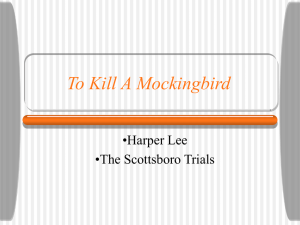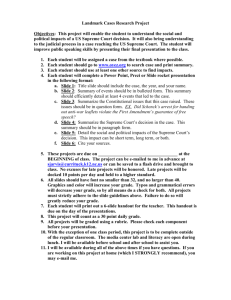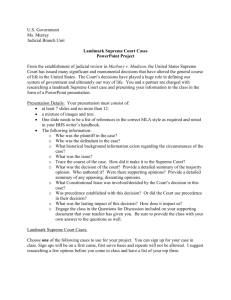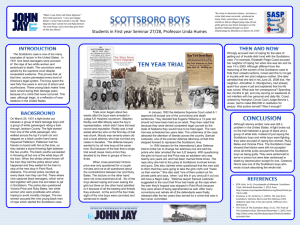The Scottsboro Boys and Fundamental Rights
advertisement
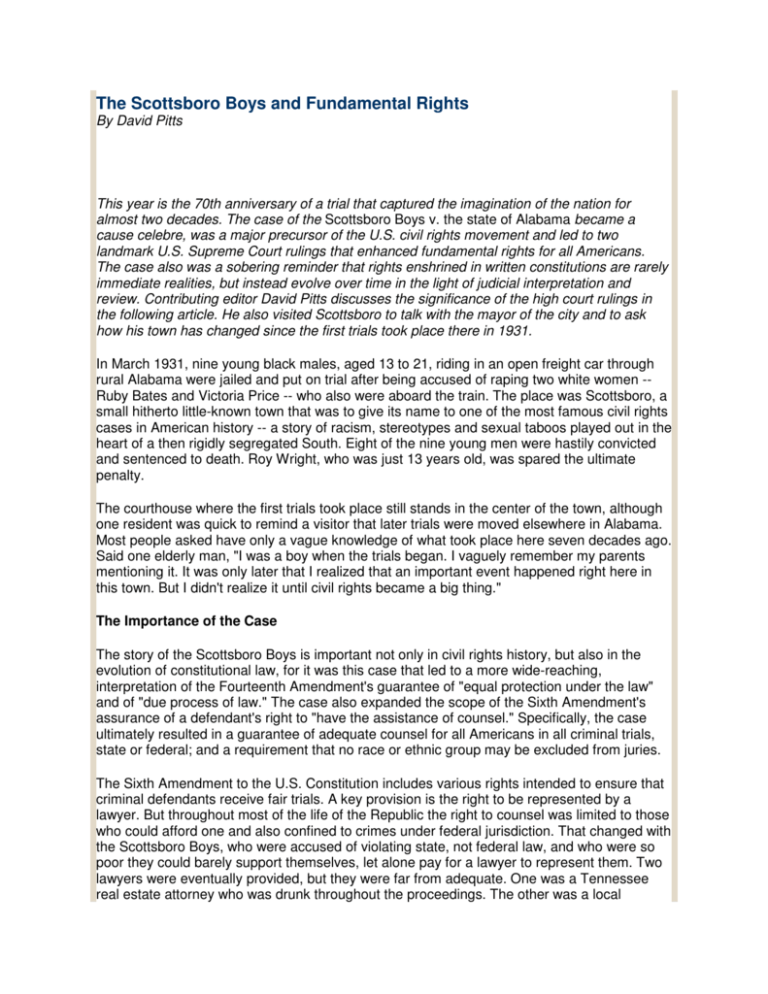
The Scottsboro Boys and Fundamental Rights By David Pitts This year is the 70th anniversary of a trial that captured the imagination of the nation for almost two decades. The case of the Scottsboro Boys v. the state of Alabama became a cause celebre, was a major precursor of the U.S. civil rights movement and led to two landmark U.S. Supreme Court rulings that enhanced fundamental rights for all Americans. The case also was a sobering reminder that rights enshrined in written constitutions are rarely immediate realities, but instead evolve over time in the light of judicial interpretation and review. Contributing editor David Pitts discusses the significance of the high court rulings in the following article. He also visited Scottsboro to talk with the mayor of the city and to ask how his town has changed since the first trials took place there in 1931. In March 1931, nine young black males, aged 13 to 21, riding in an open freight car through rural Alabama were jailed and put on trial after being accused of raping two white women -Ruby Bates and Victoria Price -- who also were aboard the train. The place was Scottsboro, a small hitherto little-known town that was to give its name to one of the most famous civil rights cases in American history -- a story of racism, stereotypes and sexual taboos played out in the heart of a then rigidly segregated South. Eight of the nine young men were hastily convicted and sentenced to death. Roy Wright, who was just 13 years old, was spared the ultimate penalty. The courthouse where the first trials took place still stands in the center of the town, although one resident was quick to remind a visitor that later trials were moved elsewhere in Alabama. Most people asked have only a vague knowledge of what took place here seven decades ago. Said one elderly man, "I was a boy when the trials began. I vaguely remember my parents mentioning it. It was only later that I realized that an important event happened right here in this town. But I didn't realize it until civil rights became a big thing." The Importance of the Case The story of the Scottsboro Boys is important not only in civil rights history, but also in the evolution of constitutional law, for it was this case that led to a more wide-reaching, interpretation of the Fourteenth Amendment's guarantee of "equal protection under the law" and of "due process of law." The case also expanded the scope of the Sixth Amendment's assurance of a defendant's right to "have the assistance of counsel." Specifically, the case ultimately resulted in a guarantee of adequate counsel for all Americans in all criminal trials, state or federal; and a requirement that no race or ethnic group may be excluded from juries. The Sixth Amendment to the U.S. Constitution includes various rights intended to ensure that criminal defendants receive fair trials. A key provision is the right to be represented by a lawyer. But throughout most of the life of the Republic the right to counsel was limited to those who could afford one and also confined to crimes under federal jurisdiction. That changed with the Scottsboro Boys, who were accused of violating state, not federal law, and who were so poor they could barely support themselves, let alone pay for a lawyer to represent them. Two lawyers were eventually provided, but they were far from adequate. One was a Tennessee real estate attorney who was drunk throughout the proceedings. The other was a local attorney who had not tried a case in decades. The First Landmark Supreme Court Ruling In a landmark ruling in the Scottsboro case, Powell v. Alabama (1932), named after one of the nine defendants, the U.S. Supreme Court declared that poor defendants facing the death penalty must be provided with adequate counsel. The Court based its decision largely on the due process clause of the Fourteenth Amendment to the U.S. Constitution. In overturning the death sentences, the Court majority determined that the Scottsboro Boys' defense was, to say the least, inadequate. The Supreme Court ruling said that counsel was "fundamental" to due process in cases of this seriousness, whether in a state or federal court. "In reversing the convictions," writes Donald Lively in his book, Landmark Supreme Court Decisions, "the Supreme Court determined that the complexities of a criminal trial require the right to have counsel present." Although Powell v. Alabama was a limited decision in that it applied only to capital cases, constitutional experts say it has had a substantial impact on American jurisprudence since, for the first time, a right to counsel was established for state, as well as federal courts. In addition, as the U.S. Constitutional Law Dictionary explains, "it tied the Sixth Amendment counsel clause to the states through the due process clause of the Fourteenth Amendment, albeit (to this point) only for capital cases at the trial stage." The significance of the ruling also was underlined by Maureen Harrison and Steve Gilbert in their book, Landmark Decisions of the United States Supreme Court. "From the beginning," they write, "our state and national constitutions and laws have laid great emphasis on procedural and substantive safeguards designed to ensure fair trials before impartial tribunals in which every defendant stands equal before the law." The Second Landmark Supreme Court Ruling Alabama, however, refused to give in, and re-prosecuted the Scottsboro case even though doctors who examined the women certified there had been no rape and even though Ruby Bates recanted her story a month before the new trials began. Death sentences were again returned for two of the defendants -- Heywood Patterson and Clarence Norris. A second landmark U.S. Supreme Court decision -- Norris v. Alabama (1935) -- again overturned the death sentences, this time because Alabama prohibited African Americans from sitting on the juries. The unanimous decision spoke of the "the unvarying and wholesale exclusion" of blacks from the juries and called the idea that African Americans were not qualified to serve, as some had alleged, "a violent presumption." Commenting on the Norris ruling's significance, The Oxford Guide to U.S. Supreme Court Decisions says the high court held "that the systematic exclusion of African Americans from service on the grand jury and trial jury denied African American defendants in the state courts (of Alabama) the equal protection of law guaranteed by the Fourteenth Amendment." They were, in fact, denied a fair trial by an impartial jury, writes James Goodman in his widely acclaimed book, Stories of Scottsboro. "In a unanimous opinion, the U.S. Supreme Court agreed with the defense that Negroes had been arbitrarily and systematically excluded from Alabama's jury rolls in violation of the equal protection clause of the Fourteenth Amendment." Despite the two U.S. Supreme Court rulings against the prosecution, the state of Alabama once again persisted in holding more trials. Eventually five of the men were convicted and served long jail sentences, the last being released in 1950. The other four were set free. Although the U.S. Supreme Court did not save five of the Scottsboro boys from prison, it did ensure that they were not executed. Constitutionally, the significance of the case is that the U.S. Supreme Court had committed itself to the right to adequate counsel, at least in capital cases. It also had served notice that excluding citizens from jury service based on race would not be tolerated. The 1935 Norris v. Alabama decision ultimately -- but not immediately -- led to the abolition of all-white juries throughout the South. Four of the nine Scottsboro Boys with Samuel Leibowitz, one of the attorneys in the case. From left, Willie Robertson, Eugene Williams, Leibowitz, Roy Wright and Olen Montgomery. AP Photo. Later Court Decisions With regard to the Powell v. Alabama decision, subsequent Supreme Court rulings strengthened the right to counsel guarantee. In Johnson v. Zerbst (1936), the nation's highest court declared that all defendants facing felony charges in federal court must be provided with attorneys. Previously (since 1790), it had been the case that only persons charged with capital crimes in a federal court must be provided an attorney. In the 1940s, the right was expanded by the Court to cover state felony defendants facing state charges less serious than those faced by the Scottsboro Boys. Many state supreme courts also acted to require that counsel be provided -- in particular in felony criminal cases. As late as 1963, however, there were still seven states that failed to require that lawyers be provided for all state felony defendants. The U.S. Supreme Court brought the entire country into line with its decision in Gideon v. Wainwright (1963) which applied the Sixth Amendment right to counsel to all state, as well as federal courts in felony cases. "The right of one charged with a crime to counsel may not be deemed fundamental and essential to fair trial in some countries," declared Justice Hugo Black, "but it is in ours." The decision was the essential culmination of one of the most dramatic stories in U.S. constitutional law -- chronicled in detail in the 1964 book, Gideon's Trumpet. "Gideon is a decision of extraordinary importance," say Lee Epstein and Thomas Walker in their widely quoted book, Constitutional Law for a Changing America. It brought "legal representation to a class of defendants who previously did not enjoy the services of an attorney." Subsequent Supreme Court rulings in the late 1960s, and especially the early 1970s, broadened the universal right to counsel established in 1963. In 1972, the Court held that the right to counsel applied not only to state and federal defendants charged with felonies, but in all trials of persons who could receive a jail sentence if convicted. The nation had come a long way since nine young frightened African Americans stood in a hot, dusty Alabama courtroom in the spring of 1931 on trial for their lives. In the case of the Scottsboro Boys, however, the U.S. Supreme Court intervened, triggering a series of major rulings that enhanced fundamental rights for all Americans and ensuring that this particular racial drama would become legend not only in civil rights history, but also in the long evolution of American jurisprudence. It is a case that incited much passion and debate in the 1930s and that still reverberates in our own time, affirming the principle of equal protection under the law.
